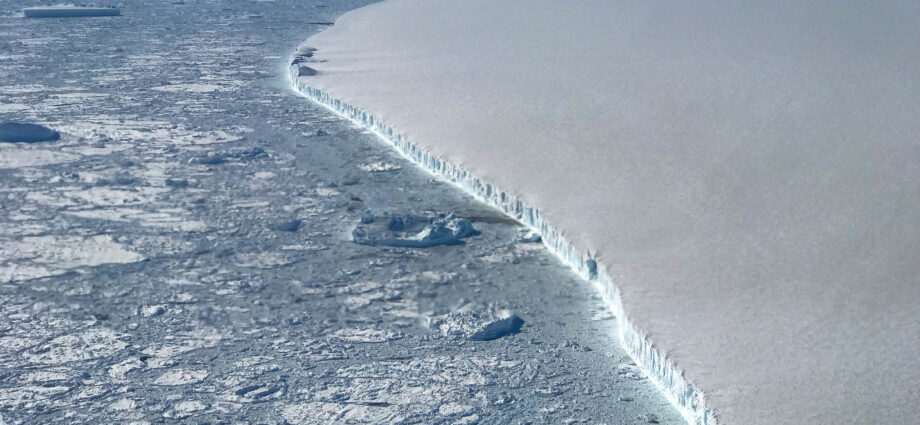
Clues to what’s happening to Antarctica’s ice-sheets – and the world’s sea levels – can be found 127,000 years in the past
by Dr Laurie Menviel, UNSW Sydney
May 28, 2024
The rapid retreat of Antarctic sea ice associated with unprecedented warming points to a lasting change in the Southern Ocean. And it holds a warning of rising sea levels for the rest of the planet.
A better understanding of climate-related Antarctic ice-sheet processes is urgently needed to gain more confidence in sea-level projections. One way to do this is to study past events of Antarctic ice-sheet melting and compare them with what is happening now.
Global temperatures in 2023 were higher than ever recorded – 1.4 degrees Celsius above the average in the late 19th century, when record keeping began.
This heat, driven by carbon emissions, is disproportionately affecting the polar regions. In the Southern Ocean surrounding Antarctica, sea ice has decreased by 40% since 2015, reaching a record low in February 2023.
More than 40% of Antarctica’s ice shelves, tongues of ice that extend from the Antarctic ice sheet and stabilise it, have shrunk since 1997, due to ocean warming at depth around Antarctica.
Along with this has been an acceleration of ice-mass loss from the Antarctic ice-sheet, reaching 150 gigatons per year between 2012 and 2016.
For comparison, one gigaton, or a billion tons, of ice would cover Sydney’s Central Business District (2.8 square kilometres) to a height of 389 metres. (To give you an idea of how deep that is, the Eiffel Tower is 300 metres tall.)
Shrinking ice mass means rising sea levels. Future projections suggest that the melting of Antarctica over the coming century could lead to a sea-level rise of up to 30 cm.
As a rule of thumb, for every 10 cm rise in sea level, the frequency of one-in-100-year coastal flooding events increases by a factor of three.
These projections come with large uncertainties, but the likelihood of the West Antarctic ice-sheet crossing a tipping point above 1.5 degrees Celsius global warming is high.
The complete melting of the West Antarctic ice sheet would lead to a sea-level rise of about 3 metres, which would inundate low-lying islands and coastal regions around the world. The much larger East Antarctic ice sheet stores an equivalent of around 60 metres of sea level.

Past changing conditions in Antarctica can provide important clues about what the future could look like.
Climate scientists have given much attention to the last interglacial period, which occurred about 127,000 years ago, as it was the warmest period of the past 800,000 years.
While the globally averaged temperature of that time was similar to today, the global mean sea level was 3 to 6 metres higher than it is today, mainly due to melting of the Antarctic ice sheet.
New modelling simulation sheds light on the processes leading to this ice-sheet melting.
When placed under last interglacial conditions (higher incoming solar radiation in the northern hemisphere summer, but lower atmospheric carbon-dioxide concentration than today), this climate model shows around a 50% loss in sea-ice cover in the Southern Ocean.
In turn, this loss in sea-ice cover amplifies the warming process, as open ocean absorbs heat more efficiently than sea ice does. It also reduces the formation of one of the world’s main deep-water masses, Antarctic Bottom Water.
The simulated result is a significant warming (up to 3 degrees Celsius) at depth on the Antarctic continental shelf.
Ocean warming below these ice shelves is very efficient at melting the ice. Since ice shelves stabilise the Antarctic ice sheet, the loss of ice shelves ultimately leads to an acceleration in Antarctic ice mass loss.
Additional climate modelling experiments show that an initial melting of the Antarctic ice sheet can be further amplified through two positive feedbacks.
First, the associated increase in meltwater from Antarctic ice-sheet melting further stabilises the water column, enhancing the sub-surface warming.
Second, a loss of mass from Antarctica leads to atmospheric warming and modified atmospheric circulation over Antarctica, which can potentially amplify the ice-mass loss.
The processes highlighted in these studies can explain why the Antarctic ice sheet partially melted during the last interglacial period.
They further suggest that the recent decrease in Antarctic sea ice cover could be setting the stage for an acceleration of ice-mass loss from Antarctica.
** **
This article was originally published by 360info™. Dr Menviel’s research was funded by the Australian Research Council.
Subscribe to our newsletter.
This article was originally published on IMPAKTER. Read the original article.

